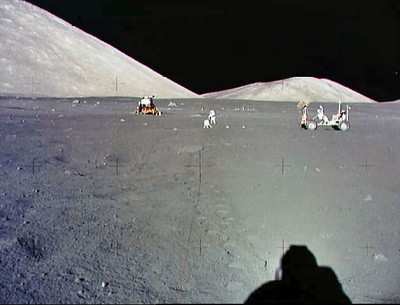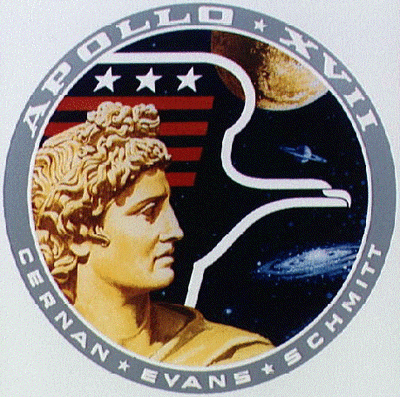Sun, Dec 12, 2010
And No One Has Returned
Where were you the better part of 40 years ago? Well... some of
us have better memories to look back upon then others. NASA has
been celebrating the 40th Anniversary of the Apollo moon landings
since last year as Apollo 11's efforts turned to a ripe old
age.

In the case of the crew of Apollo 17 just 38 years ago, today,
they were exploring the moon, the last men from Earth to do so.
Apollo 17 carried the only trained geologist to walk on the surface
of the moon, lunar module pilot Harrison Schmitt. Over the course
of scant hours, the crew of Apollo 17 covered the greatest distance
of all the crews, using the Lunar Roving Vehicle, while also coming
home with the largest treasure trove of lunar rock and soil
samples. Eugene Cernan, much to his regret, holds the unfortunate
distinction of being the last man to walk on the Moon, as NASA's
future lunar exploration plans were gutted by budget cuts
thereafter.

According to NASA resources, the lunar landing site was the
Taurus-Littrow highlands and valley area. This site was picked for
Apollo 17 as a location where rocks both older and younger than
those previously returned from other Apollo missions and from the
Luna 16 and 20 missions might be found.

The mission was the final in a series of three 'J-type' missions
planned for the Apollo program. These J-type missions can be
distinguished from previous G and H-series missions by extended
hardware capability, larger scientific payload capacity and by the
use of the battery powered Lunar Roving Vehicle (LRV).

Scientific objectives of the Apollo 17 mission included
geological surveying and sampling of materials and surface features
in a preselected area of the Taurus-Littrow region, deploying and
activating surface experiments, and conducting inflight experiments
and photographic tasks during lunar orbit and transearth coast
(TEC). These objectives included: Deployed experiments such as the
Apollo lunar surface experiment package (ALSEP) with a Heat Flow
experiment, Lunar seismic profiling (LSP), Lunar surface gravimeter
(LSG), Lunar atmospheric composition experiment (LACE) and Lunar
ejecta and meteorites (LEAM). The mission also included Lunar
Sampling and Lunar orbital experiments. Biomedical experiments
included the Biostack II Experiment and the BIOCORE
experiment.

Cernan and Schmitt spent 75 hours on the surface of the moon.
There are, at present, no concrete plans to return to earth's only
natural satellite.
More News
Aero Linx: International Flying Farmers IFF is a not-for-profit organization started in 1944 by farmers who were also private pilots. We have members all across the United States a>[...]
From 2017 (YouTube Version): Remembrances Of An Israeli Air Force Test Pilot Early in 2016, ANN contributor Maxine Scheer traveled to Israel, where she had the opportunity to sit d>[...]
"We renegotiated what our debt restructuring is on a lot of our debts, mostly with the family. Those debts are going to be converted into equity..." Source: Excerpts from a short v>[...]
Also: B-29 Superfortress Reunion, FAA Wants Controllers, Spirit Airlines Pulls Back, Gogo Galileo Van's Aircraft posted a short video recapping the goings-on around their reorganiz>[...]
Chart Supplement US A flight information publication designed for use with appropriate IFR or VFR charts which contains data on all airports, seaplane bases, and heliports open to >[...]
 ANN's Daily Aero-Linx (04.15.24)
ANN's Daily Aero-Linx (04.15.24) Classic Aero-TV: 'No Other Options' -- The Israeli Air Force's Danny Shapira
Classic Aero-TV: 'No Other Options' -- The Israeli Air Force's Danny Shapira Aero-News: Quote of the Day (04.15.24)
Aero-News: Quote of the Day (04.15.24) Airborne 04.16.24: RV Update, Affordable Flying Expo, Diamond Lil
Airborne 04.16.24: RV Update, Affordable Flying Expo, Diamond Lil ANN's Daily Aero-Term (04.16.24): Chart Supplement US
ANN's Daily Aero-Term (04.16.24): Chart Supplement US







